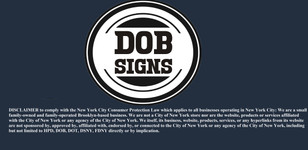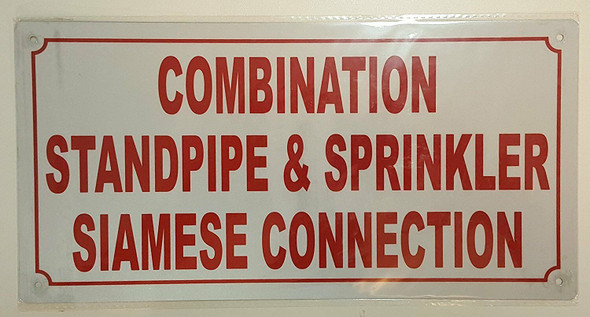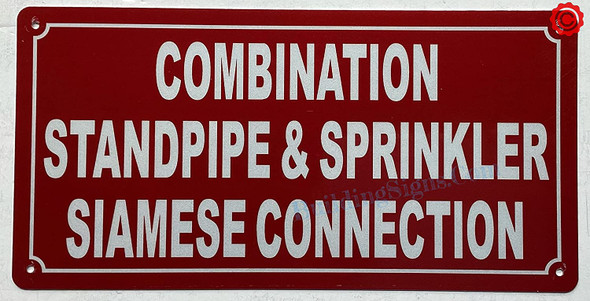construction signs ny
Combination Standpipe & Sprinkler Siamese Connection Sign (Silver, Rust Free,Aluminium 6x12)
- UPC:
- 880850014170
- Availability:
- USUALLY SHIP WITH IN 1-2 BUSINESS DAY
Description
Combination Standpipe & Sprinkler Siamese Connection Sign (white, Rust Free,Aluminium 6x12)
Size: 6x12
Material: Aluminum
Color: White
There are different types of standpipe combination system:
· Automatic dry standpipe system
· Automatic wet standpipe system
· Combined system
· Manual dry standpipe system
· Manual wet standpipe system
· Semiautomatic dry standpipe system
· Wet standpipe system
What is a combination standpipe? A combined system consists both of sprinkler piping and is a standpipe for the building. The combined system is hydraulically calculated for both sprinkler flow and fire hose flow needed for the building in case of emergency
What is the difference between standpipe and sprinkler? Standpipe systems are designed to provide fire protection water for hose lines in strategically placed locations inside a building or structure. Some older buildings only have standpipe systems while many newer buildings will have a combination system, which supplies the fire sprinkler system and the standpipe system
What is a sprinkler standpipe? Standpipe systems are a series of pipe which connect a water supply to hose connections, basically an extension of the fire hydrant system. Some older buildings only have standpipe systems while many newer buildings will have a combination system, which supplies the fire sprinkler system and the standpipe system
Our standpipe signs are designed to inform 1st respondents about the standpipe system in the building and their locations. A Standpipe system is a series of pipes which connect a water supply to hose connections, basically an extension of the fire hydrant system. They are designed to provide a pre-piped water system for building occupants or the fire department.
A standpipe system is an arrangement of piping, valves hose connections and other equipment installed in a building or structure, with the hose connections located in such a manner that water can be discharged in streams through attached hose and nozzles, for the purposes of extinguishing a fire, thereby protecting a building or structure and its contents in addition to protecting the occupants. This is accomplished by means of connections to water supply systems or by means of pump tanks and other equipment necessary to provide an adequate supply of water to the hose connections.”
It is, essentially, a way of delivering water from one area of the structure or facility to another so that we can fight the fire while at the same time shortening the length of the supply and attack lines. Standpipes can be an intricate or simple system, but the result is the same: water delivery. These systems can be vertical (which is the common type) or they can be horizontal.
Below are four types of standpipes that you will find in use:
· Wet system. Here, water is in the pipes at all times and is supplied by a water source. The pressure in the system is constantly maintained.
· Automatic dry standpipe. Here, there is always air stored inside the standpipe at a constant pressure. When a hose valve is opened, the air escapes allowing the water to enter into the standpipe system.
· Semi-automatic dry standpipe. In this system, air is stored inside the pipes, which can be pressurized or not be pressurized. Once an actuation device such as a manual pull station or an electrical switch is activated, water then enters the system.
· Manual dry standpipe. This type of system has only pipes feeding the system with no air or water in them. A fire apparatus must be used to supply the water through the standpipe.
What is a standpipe system used for? Standpipe systems are a series of pipe which connect a water supply to hose connections, basically an extension of the fire hydrant system. They are designed to provide a pre-piped water system for building occupants or the fire department
How does a standpipe work? In North America, a standpipe is a type of rigid water piping which is built into multi-story buildings in a vertical position or bridges in a horizontal position, to which fire hoses can be connected, allowing manual application of water to the fire.
What is the most common standpipe system? Class III Systems: A “Class I” standpipe is the most common type of fire protection standpipe system today. Class I standpipes are required due to the International Building Code, Chapter 9 requirements. The code specifically states in
What are the components of a standpipe system? Basic Components of Standpipe Systems. While each system can vary, a standpipe generally consists of an interconnected series of pipe, pumps, valves, alarms, drains, and fire department connections
What are the four types of standpipe systems?
· Wet system. Here, water is in the pipes at all times and is supplied by a water source. ...
· Automatic dry standpipe. Here, there is always air stored inside the standpipe at a constant pressure. ...
· Semi-automatic dry standpipe. ...
· Manual dry standpipe.
What is a standpipe test? A standpipe is the vertical piping that connects fire sprinkler systems and hose stations between multiple floors. It is common to see standpipes in stairwells of high-rise buildings. A rooftop standpipe test verifies the water supply, pump and piping at the topmost part of the system
What is the difference between standpipe and sprinkler? Standpipe systems are designed to provide fire protection water for hose lines in strategically placed locations inside a building or structure. Some older buildings only have standpipe systems while many newer buildings will have a combination system, which supplies the fire sprinkler system and the standpipe system
How does a wet standpipe system work? A "wet" standpipe is filled with water and is pressurized at all times. In contrast to dry standpipes, which can be used only by firefighters, wet standpipes can be used by building occupants. Wet standpipes generally already come with hoses so that building occupants may fight fires quickly
What is a combination standpipe? Combined System -A standpipe system having piping. result in a gridded dry sprinkler system due to the cross or. that supplies both hose connections and automatic. interconnection piping. Once the final design applicability
What is a standpipe riser? Riser is the vertical supply pipes in a sprinkler system. Standpipe is the system piping that delivers the water supply for hose connection, and for sprinklers on combined system, vertically from floor to floor.
Our combination standpipe and sprinkler Siamese connection sign – Design to inform 1st responded about the type of combination system in the building. A combination standpipe and sprinkler system is a standpipe system that supplies both hose connections and automatic sprinklers.The combination Standpipe siamese connection is a splitter in fire protection engineering is a pipe fitting that allows two or more fire hoses to be connected to a single combination standpipe sprinkler riser at the same general location. It is so-called due to the visual similarity to Siamese twins for a standpipe and sprinkler connection.
Our Automatic sprinkler signs – Design to inform 1st responded about the sprinkler system on the building. An Automatic Fire Sprinkler System is a network of water-filled pipes which starts at your domestic water service line and ends with strategically spaced fire sprinkler heads located throughout your home.
Automatic Sprinkler control valve signs – The signs design to inform the fire department the location and designation of the valve of the flow of water from mainline to each zone.
What is the most common type of automatic sprinkler system? Wet pipe systems are the most common type of fire sprinkler systems. These systems are filled with water from an automatic source, and when a sprinkler head is exposed to enough heat, the heat-sensitive element will release and water will be allowed to flow from that sprinkler.
What is an FDC? FDC define as Fire Department Connection. The fire department required owner to put a clear signs where the FDC in the building is. Fdc sign need to be clear and easy to read with strong contrast between the letters and background.
What are the Three most command fire sprinkler system?
- Wet pipe systems-Wet pipe systems are definitely the most commonly used fire sprinkler systems.
- Dry pipe systems. These are the second most popular fire sprinkler system type. ...
- Deluge systems.
Fire Sprinkler Signs- The signs are design to identify different controls and pipes for fire sprinkler systems in your facility. A fire sprinkler or sprinkler head is the component of a fire sprinkler system that discharges water when the effects of a fire have been detected. Many state required owners to install clear signs of what type of fire sprinkler he has on his facility.
There are various types of fire below you will find 4 type of fire system:
Dry Pipe Sprinkler system-Dry pipe sprinklers are similar to pre-action systems as they use pressurized air in the pipe which exits before water escapes. This causes a minute delay in water discharge but is ideal for buildings with low temperatures so the pipes do not freeze. These fire sprinkler systems have a fast opening tool to get rid of the air and speed up the flow of water. Warehouses located in the north are a good example of what buildings should use dry pipe sprinklers.
Wet Pipe Sprinkler system-Wet pipe fire sprinklers constantly have water in them. This allows for a quick reaction to a fire and is the most common type of sprinkler installed in buildings. A type of building that uses the wet pipe system is a high-rise or office building with a few floors. This fire sprinkler system is cost efficient and low maintenance.
Pre-action fire sprinkler system-Pre-action fire sprinkler systems are filled with air and water is allowed to pass through when the smoke alarm or detector goes off. This type of system requires two triggers to start water flow. It helps greatly that the pre-action fire sprinkler can be set to prevent water from spouting in case of a false alarm or a mechanical failure. The pre-action system is good for use in places where the sprinklers are only necessary when there is an actual fire so other items in the building do not get water damage from an accidental sprinkling. Such buildings include libraries and data centers. These places contain items of high value like electronics and goods damageable by water such as books
Deluge Fire Sprinkler -These types of fire sprinkler systems also need a smoke or heat detector like the pre-action system. A deluge system has open nozzles that can be used when a hazard is present. When flammable liquids are spread across a floor, deluge fire sprinklers are good to have. In that case, buildings such as industrial parks and buildings with many tanks have deluge fire sprinkler systems installed.
Shipping and Handling Cost:
Our Shipping is fixed whether you buy 1 item or 20 items (We ship within USA only) - do not miss this opportunity to buy all signs needed at no additional shipping cost.
Sales Tax:
We are required to collect sales tax on any product sold on this site and shipped to an address in New York. The sales tax is 8.875 percent.
DISCLAIMER to comply with the New York City Consumer Protection Law which applies to all businesses operating in New York City: HPD-signs.com is a small family-owned and family-operated Brooklyn-based business. HPD-signs.com is not a City of New York store nor are the website, products or services affiliated with the City of New York or any agency of the City of New York. HPD-signs.com itself, its business, website, products, services, or any hyperlinks from its website are not sponsored by, approved by, affiliated with, endorsed by, or connected to the City of New York or any agency of the City of New York, including but not limited to HPD, DOB, DOT, DSNY, FDNY directly or by implication.
The requirements for sign content are determined by intended use and by applicable regulation. The BUYER is responsible for determining the appropriate content for a sign or package of signs. We makes no warranty or representation of suitability of a sign for any specific application. IT IS THE CUSTOMER'S RESPONSIBILITY TO ENSURE THAT THE SIGNS THE CUSTOMER ORDERS ARE IN COMPLIANCE WITH ALL STATE, FEDERAL, LOCAL, AND MUNICIPAL LAWS. Please review terms and conditions prior to purchase.
The codes may not be the most recent version. The State / federal or other regulation department may have more current or accurate information. We make no warranties or guarantees about the accuracy, completeness, or adequacy of the information contained on this site or the information linked to on the state site. Please check official sources.
For more information about what is required, see the laws that are referenced and the rules applicable to your city and state. This page is for informational purposes only and is not intended as legal advice, professional advice or a statement of law. You may wish to consult with an attorney.
We provide both signs required by city and state regulation and Property Management Signs , DOB Signs , Hallway Signs , HPD Signs , Fire Department Signs , Floor Identification Signs , Door Signs , Building Directional Signs , Floor Number Signs , Building Signs , Silver Signs, ADA signs and many more in stock and ready to ship.
























